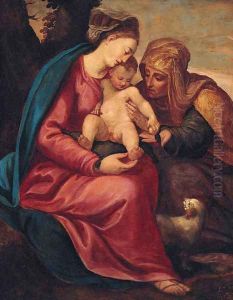Christofano Allori Paintings
Christofano Allori was an Italian portrait painter of the late Renaissance and early Baroque periods. Born on October 17, 1577, in Florence, Italy, he was deeply embedded in the rich cultural and artistic heritage of the city, which was a center of the arts during this time. Christofano was the son of the prominent Florentine painter Alessandro Allori, which provided him with a strong artistic foundation and connection to the art world from a young age. Under the guidance of his father, Christofano developed his painting skills, though he would eventually go on to forge his own distinct style.
Allori's work was influenced by the Mannerist style, which was characterized by artificiality, grace, and elegance, but he also incorporated the emerging Baroque sensibility with its emphasis on realism and emotion. One of his most famous works, 'Judith with the Head of Holofernes' (circa 1613), showcases his ability to blend these styles. The painting is noted for its dramatic use of light and shadow, a technique known as chiaroscuro, as well as its psychological depth and realism. The model for Judith in this painting was reportedly his former lover, the noblewoman Mazzafirra, and Allori's self-portrait is said to be represented in the severed head of Holofernes, adding a personal dimension to the work.
Throughout his career, Allori received numerous commissions from wealthy patrons and religious institutions, which allowed him to create a diverse body of work ranging from altarpieces to portraits. Despite his success, he struggled with personal issues and had a somewhat turbulent life, which was not uncommon among artists of his time.
Christofano Allori passed away on April 22, 1621, in Florence. His legacy is that of a skilled painter who managed to capture the transition from the refined elegance of Mannerism to the more emotionally charged and dynamic Baroque style. Today, his works are displayed in many major museums and galleries around the world, and he is recognized as an important figure in the development of Italian painting.
